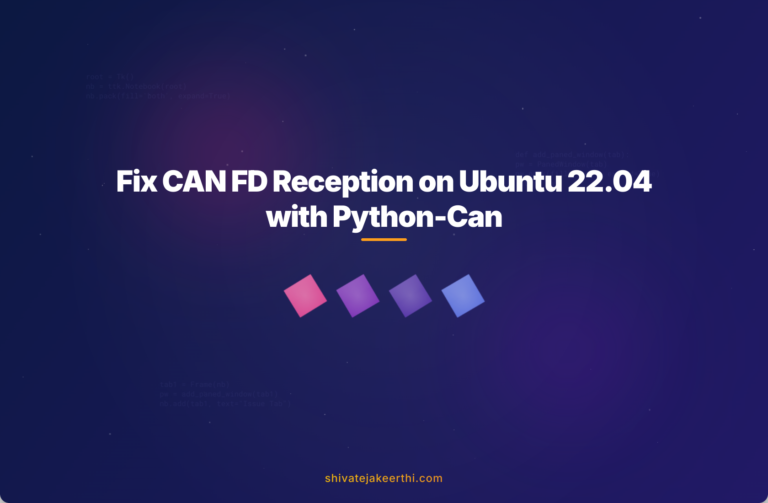Working with CAN FD interfaces on Ubuntu 22.04 can sometimes result in confusing issues, especially if you’re using Python scripts like can_bridge.py. A common scenario is encountering an issue where your Python script can’t receive CAN FD messages through the bus0.recv(timeout=1.0) function. While standard CAN messages might work fine, the CAN FD messages simply aren’t coming through. Let’s walk through a step-by-step troubleshooting approach to pinpoint most common pitfalls and get you back on track.
Overview of the Issue
Description of the Problem
When running Python applications utilizing the python-can library, users frequently come across an issue where CAN FD (Flexible Data-rate) messages aren’t received by bus0.recv(). The program stalls or returns None, even though messages are actively being sent from another interface.
Environment Setup
For clarity, our troubleshooting example environment includes:
- Ubuntu Linux 22.04 (Jammy Jellyfish)
- Python 3.10+
- Python-CAN library installed via pip:
pip install python-can - Two CAN FD interfaces configured using SocketCAN (usually CAN0 and CAN1)
- A custom Python script can_bridge.py intended to forward messages from CAN0 to CAN1 and vice versa
Investigating the Problem
To begin troubleshooting, run your Python script can_bridge.py to identify if basic CAN message communication works:
python3 can_bridge.py
Verify connection status by sending basic CAN messages from CAN0 to CAN1 using standard CAN utilities available in Ubuntu provided by the can-utils package:
sudo apt install can-utils
cansend can0 123#1122334455667788
candump can1
If standard CAN messages appear successfully in the candump output, your basic setup is working fine. Next, let’s specifically test CAN FD functionality. Send a CAN FD message explicitly:
cansend can0 111##112233445566778899
candump -f can1
If this CAN FD message doesn’t show up at the receiving interface: we’ve located our real issue.
Troubleshooting Steps
Checking Hardware and Configuration
Often, the root cause can be traced back to a missing configuration for CAN FD support or hardware-level incompatibilities:
- Check your interface configuration by running:
ip -details link show can0 - Ensure CAN FD mode is explicitly enabled when bringing up your SocketCAN interfaces. For example, the correct CAN FD activation looks like this:
sudo ip link set can0 type can bitrate 500000 dbitrate 2000000 fd on
sudo ip link set up can0
Make sure dbitrate (data bitrate) and fd on are provided explicitly. Without these settings, CAN FD messages can’t be processed correctly.
Analyzing can_bridge.py Code
Your Python script itself might be the issue. The default SocketCAN interface in python-can requires explicit enabling of CAN FD support. Check carefully to ensure the fd=True parameter is included in your connection code:
bus0 = can.interface.Bus(channel='can0', interface='socketcan', fd=True)
bus1 = can.interface.Bus(channel='can1', interface='socketcan', fd=True)
If you missed the fd=True option, your bus won’t recognize CAN FD frames, resulting in silent failures when trying to receive messages.
Understanding the can_bridge.py Code
Let’s briefly outline the typical structure of the can_bridge.py script clearly:
- Importing libraries: The script imports the python-can library to interact with CAN peripherals.
- Interface setup: Opens CAN interfaces with SocketCAN and CAN FD enabled.
- Message handling logic: Listens continuously for incoming CAN FD frames using polling to forward them between interfaces.
A simplified CAN FD ready version might look like this:
import can
bus0 = can.interface.Bus(channel='can0', interface='socketcan', fd=True)
bus1 = can.interface.Bus(channel='can1', interface='socketcan', fd=True)
while True:
msg = bus0.recv(timeout=1.0)
if msg:
bus1.send(msg)
Ensure your code clearly specifies fd=True as discussed previously.
Implementing Logic for Reliable CAN FD Message Reception
In some advanced scenarios, relying solely on blocking functions like recv() may not serve you well. For increased reliability, using a polling interface is beneficial:
import can
import select
bus0 = can.interface.Bus(channel='can0', interface='socketcan', fd=True)
bus1 = can.interface.Bus(channel='can1', interface='socketcan', fd=True)
poller = select.poll()
poller.register(bus0.socket, select.POLLIN)
while True:
events = poller.poll(1000) # polling timeout: 1000ms
if events:
msg = bus0.recv()
if msg:
bus1.send(msg)
This approach explicitly checks for events with polling, ensuring improved reliability particularly on busy interfaces with CAN FD data traffic.
Further Troubleshooting CAN Bus Communication Issues
If issues persist:
- Check your physical hardware: cables, termination resistors, CAN transceivers.
- Inspect CAN interface statuses using tools such as ip link, dmesg | grep can, or inspect kernel logs thoroughly.
- Review kernel version compatibility and consider driver-level troubleshooting if necessary (Ubuntu’s Linux kernel updates may affect CAN drivers).
- Consider exploring relevant Stack Overflow posts addressing SocketCAN issues.
Additional Tips and Resources
- Always verify communication first with lower-level tools like candump or wireshark before debugging high-level Python scripts.
- Keep up-to-date with the python-can documentation for comprehensive best practices and troubleshooting guides.
- Stay informed about Python programming tutorials specifically geared towards Linux and interface communications.
Make sure your understanding of both CAN FD and Linux SocketCAN stacks is strong, as an informed approach significantly reduces frustration.
Have you faced similar challenges before, or found alternative solutions that worked even better? Feel free to share your experience or pose additional questions for community insights!



0 Comments